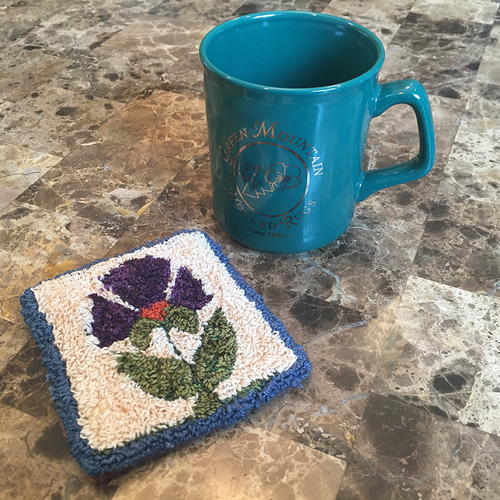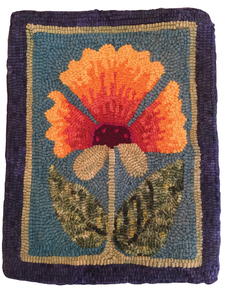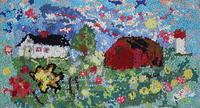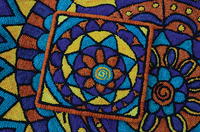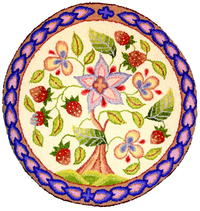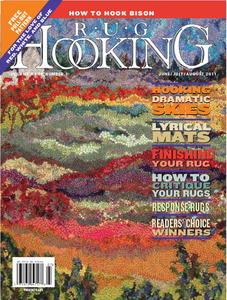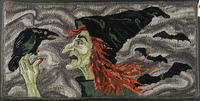Fraktur Thistle
A project for every fiber
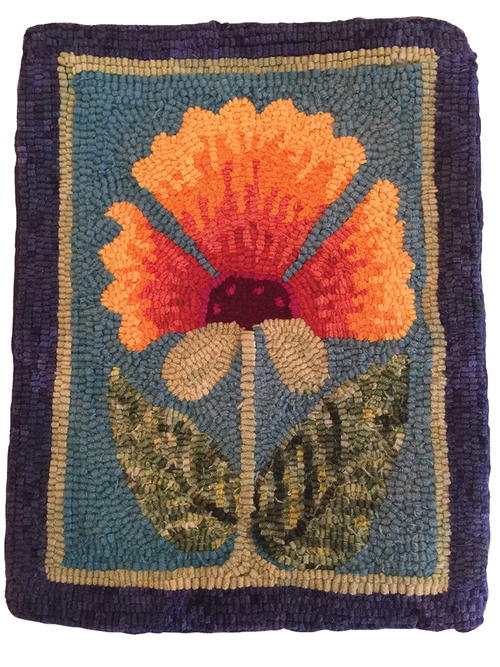
Fraktur Thistle, 9" x 12", #6-cut wool on linen. Designed by Ruckman Mill Farm and hooked by Green Mountain Hooked Rugs, Burlington, Vermont, 2017.
When the most recent generation of our family became involved with the day-to-day activities of Green Mountain Hooked Rugs, we found ourselves expanding and exploring. Our five-generation family business has always been centered on traditional rug hooking, but as the craft grows and evolves, so must we. The most recent generation has begun to explore the ways in which we can use our knowledge of rug hooking to stretch the boundaries of both our own projects and that of the craft as a whole.
Hooking with yarn is an easy and obvious transition. The way the yarn pulls through the backing is slightly different than cut wool strips. It takes some getting used to but, after a bit, one begins to get the feel of it. The biggest challenge is learning about the different yarn weights and how to achieve the desired look. When we began hooking with yarn everyone told us we needed to use rug yarn, which is typically a very thick, heavy-weight yarn. If the goal is to use a finished project as a rug to be walked on then, yes, the thickness and durability count! However, rug yarn is not always easy to find, while the thinner, softer yarns are plentiful.
We used a worsted weight on a primitive linen and it worked well enough, but it worked even better when we pulled two strands of yarn together through each hole.
We also enjoy working with wool appliqué as pictured in the March/April/May 2018 issue of Rug Hooking magazine (butterfly applique project). This is a great way to use up small scraps of wool, and small projects can easily be taken on the road. The same goes for the mini-punch needle.
All of these projects have one key ingredient—a great pattern! So we asked ourselves, “What makes a good multi-purpose pattern?”
First, scalability. A great pattern needs to look good in any size: small, medium, or large. Think carefully about patterns with a lot of detail because you will lose the detail when you shrink a complex pattern down.
Second, consider the subject matter. In order for a pattern to be a good candidate for appliqué, for example, it needs to have very clear, defined pieces. If your pattern looks more like a drawing, it may not be the best choice for appliqué. Similarly, if there is shading, it may be tough to make that detail shine through with mini-punch.
Lastly, copyright. We never miss an opportunity to discuss copyright. What if you buy a rug-hooking pattern and want to use it for mini-punch? If it is a Green Mountain pattern then you may transfer it to a different backing, but you must destroy the original pattern you purchased because you only purchased “one use.” As for other pattern designers, it’s best to check with the owner of the design before doing anything.
But why pay for a backing you won’t use? We agree. Collecting free paper patterns (like the ones you find in Rug Hooking magazine) is a great way to avoid the added cost of paying for materials you don’t need. Go back though all your old magazines and see if there are appealing patterns you can experiment with!
The thistle pattern accompanying this article has been hooked with cut wool strips and used for mini-punch, and it would make a great candidate for appliqué and hooking with yarn as well. The sky’s the limit!
To order the pattern for Fraktur Thistle, contact Rug Hooking magazine, 1-877-297-0965. Or order online here. The cost for the pattern on linen is $33.50, plus $10.00 shipping and handling. Offer expires August 31, 2018.
Designed Exclusively for Rug Hooking Magazine
Fraktur Thistle/Ruckman Mill Farm and Green Mountain Hooked Rugs
Pattern: on unbleached linen, $33.50, $10.00 S&H
NEVER MINI-PUNCHED BEFORE?
No worries, we’ve got you covered. All you need to get started is a bit of weaver’s cloth, a mini- punch needle, and some floss (we used Valdani, but you could also use embroidery floss found at your local craft store). For our mini-punch project, we looked to W. Cushing & Co. for all of the materials.
To transfer your pattern to the weaver’s cloth, use a small Sharpie or fabric marker (at first, we used a large Sharpie and it ran a bit, but it was still usable). The mini-punch needle comes with a really thorough instruction book and we were able to teach ourselves how to use it pretty easily with this as our guide. There is a size gauge on the mini-punch needle and we used a number four to outline everything and a number five to fill everything in. Once our project was complete, we cut a half-inch border around everything and glued it to the back. Then we glued a piece of wool to it as a backing to make a fun coaster!
Our best advice is to not overthink the mini-punch. As crafters, we can sometimes scare ourselves out of projects. This was our first try with it and the process seemed pretty foolproof.
-
Thistle Mug Mat, mini-punch version of the Fraktur Thistle design.
Read NextWestmoreland Ponies


